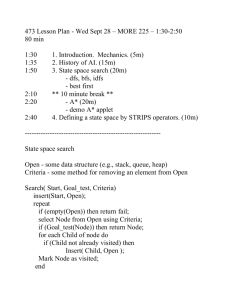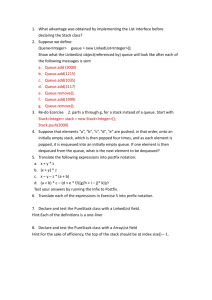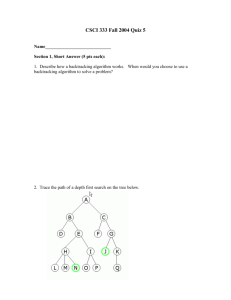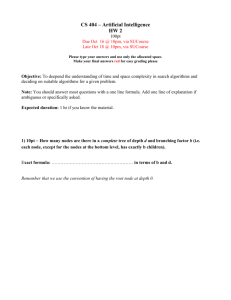L24cs211sp03
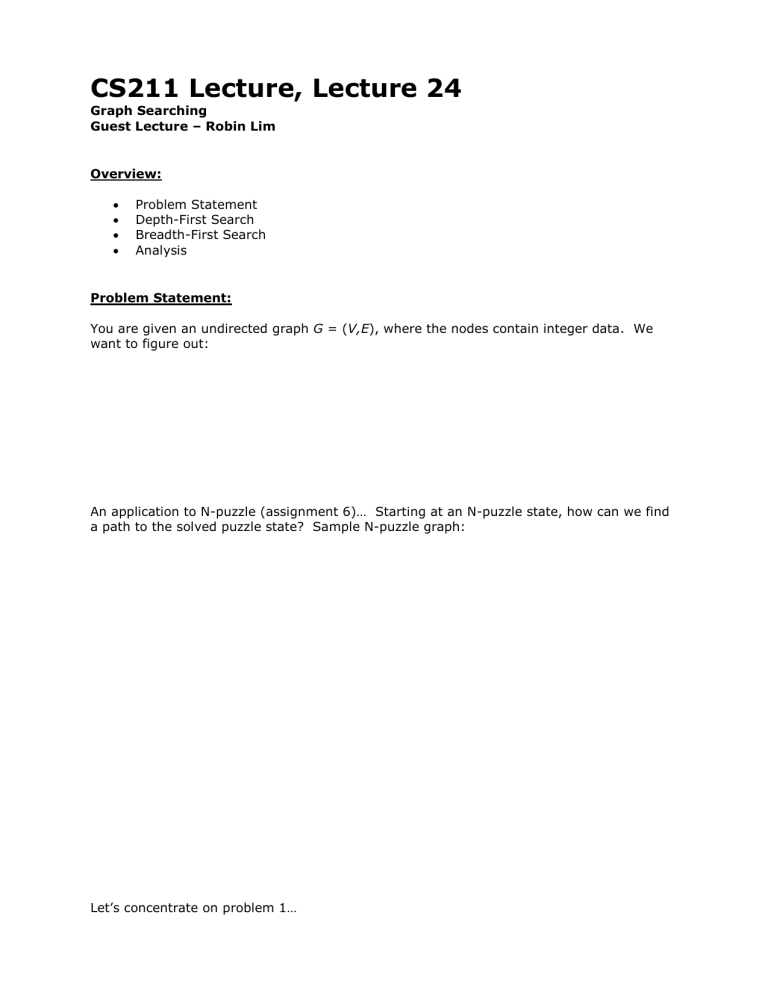
CS211 Lecture, Lecture 24
Graph Searching
Guest Lecture – Robin Lim
Overview:
Problem Statement
Depth-First Search
Breadth-First Search
Analysis
Problem Statement:
You are given an undirected graph G = (V,E), where the nodes contain integer data. We want to figure out:
An application to N-puzzle (assignment 6)… Starting at an N-puzzle state, how can we find a path to the solved puzzle state? Sample N-puzzle graph:
Let’s concentrate on problem 1…
Proposing Some Algorithms
Algorithm 1: Start at some node s, and traverse down a random outgoing edge until we find x (the value we’re searching for. o Example o Problems?
Algorithm 2: o Example o Problems?
Depth-First Search (DFS)
Need some sort of memory…
Let’s consider the following algorithm:
stack = new empty stack
current = s initialize visited = false for all nodes in G stack.push(s) while(stack is not empty) {
current = stack.pop() if (current has been visited) continue; if (value of current == x) return true
stack.push(all nodes adjacent to current that have not been visited)
Mark current as visited
} return false
Example (see example at end of notes)
Breadth-First Search (BFS)
Hmmm… Let’s throw away the stack in the above algorithm, now what?
Now consider this algorithm…
queue = new empty queue
current = s initialize visited = false for all nodes in G
queue.enqueue(s) while(queue is not empty) { current = queue.dequeue() if (current has been visited) continue; if (value of current == x) return true
queue.enqueue(all nodes adjacent to current that have not been visited)
Mark current as visited
} return false
Example (see example at end of notes)
Analysis
Running time (informal, hand-wavy argument)
What’s the main difference?
Which one is better? o Depends on the problem o Which one will probably find a shorter path solution? o Which one will probably use up less memory?
Exercises and Things to Think About
Aside from doing assignment 6, here are some helper problems that may help you understand BFS and DFS a little better…
Referring back to the “Problem Statement” of this set of notes, how would you solve problems 2 and 3 using DFS and BFS?
You could actually throw away the stack for DFS and instead use recursion to implement the algorithm. Write the pseudocode for this recursive implementation.
Say BFS starts at a start node s and is searching for a path from s to node y. Does
BFS always find the shortest path from s to y? Justify your answer. If we put weights on the edges, does BFS always return the shortest path from s to y?
How would you implement both DFS and BFS if the graph was a directed graph?
Alter the algorithms above such that they work for directed graphs.
Example for DFS
1 2 6 current
1 2 6
3 4 3 4
1
5 s = Node 1, x = Node 4
Iteration 0
2 6
1 stack bottom
1
Iteration 1
5
2 6
3
2 stack bottom current
3
Iteration 2
5
4 5
2
2 stack bottom current
3
Iteration 3
5
4
2
2 stack bottom
1 2 6 1 2 6
3
Iteration 4 current
5
4
4
2 stack bottom
3
Iteration 5
FOUND!
4 current
5 2 stack bottom
1 2
3
Queue front
1
5 s = Node 1, x = Node 4
Iteration 0
4
6
1 current
2 6
3
Queue front
3 3 4
Iteration 2
5
4
1 2 6 current
Queue front
4 5
3
5
Iteration 4
Node 3 already visited
4 current
1 2
3
Queue front
2 3
Iteration 1
5
4
6
1 2
3 current
Queue front
3 4 5
Iteration 3
5
4
1 2 6
Queue front
5
3
Iteration 5
FOUND! current
5
4
6
